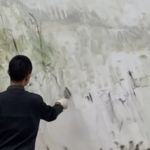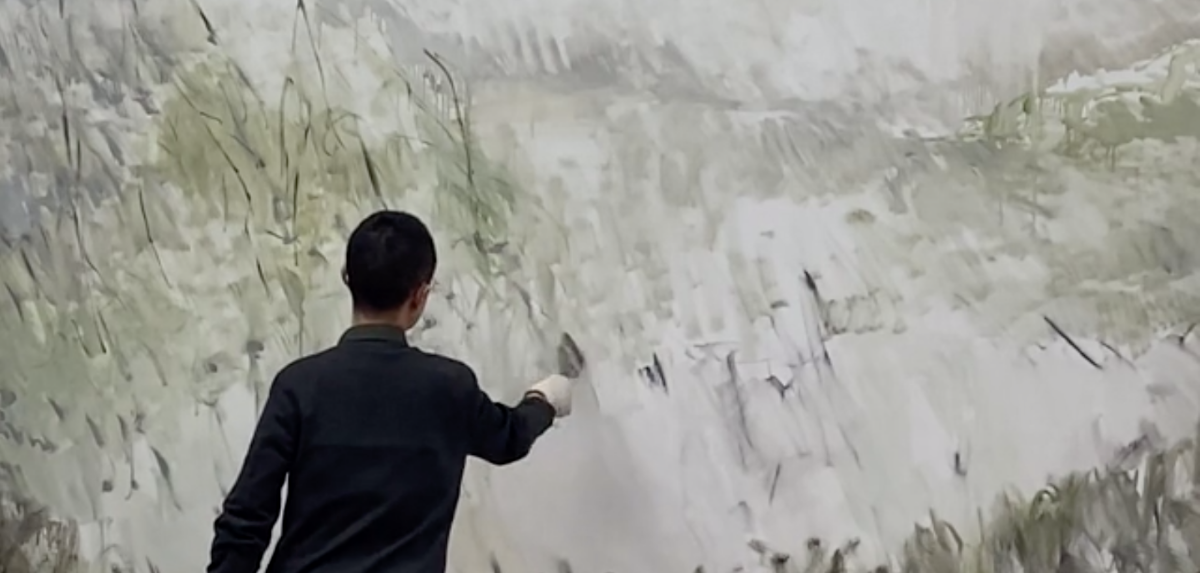
The artist acts more like an intermediate organ to provoke this sensation, calling up in the audience’s memory visions that maybe are faded away or never really accompanied by an attentive awareness.
Few weeks ago, Yang Jinsong sent me via email some files of his new landscape paintings, and I was deeply impressed and moved from these overwhelming masterpieces. His pictorial language has got a new, astonishing sovereignty.
His artistic language is not thrown over the vision like a mere personal artistic hand writing where behind the actual vision of the landscape as such fades away. On the contrary, his mode of painting brings in the foreground Nature’s life in itself, and any beholder might receive it by its own sensible response. The artist acts more like an intermediate organ to provoke this sensation, calling up in the audience’s memory visions that maybe are faded away or never really accompanied by an attentive awareness. – This is the role of great artists’ vision, to bring the audience in contact with the richness of deep memories that are often hidden behind too many everyday duties and shortcuts of visual information.
Looking at Yang Jinsong’s new landscapes, I remembered his very beginnings I shared about 20 years ago during his sojourn at Kassel Art School, invited as young guest artist from Chongqing’s Sichuan Fine Art School. From there till now, in about two decades, the artist gained from an immense observation, research and experience a maturity that dropped away all the ‘egg shells’ that put motives in all too enclosed surfaces. Three years ago, 2018 in his Solo show at Beijing’s White Box Art Centre, Jinsong concentrated for the first time on themes of landscape, large paintings giving a sense for the vastness of the Ocean, its surfaces rippled by tender wind breezes, and rows of willow trees moved in its rhythm like soft veils over the canvas. The handling of the brush had gained an open way of drawing, giving with its rhythm a feeling for the breathing atmosphere. One year later, in Autumn 2019, Beijing Lotus Art Museum combined these newer paintings with some of Jinsong’s large fish and melon paintings, realised many years ago, but all in all providing a deep impression of the artist’s far-reaching bold imagination.
But with his current works, now shown at Vermilion Art gallery, I think Yang Jinsong conquered a new, tremendous freedom in his artistic language. The motif, so to speak, is no more followed in any spelling way, but out of a sense for the unity in the vision emerging. And a new sense for the density of atmosphere allows painterly dots a new power of intermingling.
It is about ten years since the artist starts quite every day in his studio with meditative exercises in doing calligraphy, exchanging questions about all aspects of this exquisite Chinese art with a good friend and wise expert in this time-honoured field of artistic expression. Given my admiration for this practice, I often saved with the consent of the artist many a sheet with calligraphy – mere exercises, as the artist commented them that had ended up in the wastepaper bucket.
Maybe in a rather intuitive way, by now I understand the creative role, calligraphy was and is still playing as a formative counterpart of Jinsong’s painting. Of course, it is not a one-to-one application or transfer from calligraphy to painting. And as well it is not just this amazing unity of discipline and freedom all those different calligraphic writing ways are based on. Rather, it might be a kind of liberation from any descriptive illusion by the language of a brush who acts as an interplay with its materials, like canvas and coloured inks, oil or acrylic. Thus, the artist realizes his vision as an interface coming in an emotionally embracing touch with Nature’s image without violating its autonomous reality, its distance and integrity.
Fortunately, decades ago China took the decision not to give up its ancient calligraphic tradition in favour of the Western alphabet. This seemed to be more handsome for modern typewriters and printing issues. But the alphabet is giving up the creative visual link to our tangible world that calligraphy is still calling up in an imaginative way. And so, as an important cultural basis, calligraphy still provides its momentum for the whole spectrum of artistic efforts. Finally, with the algorithmic calculus of computer technology, the preservation of Chinese calligraphic characters is no more a problem but even an advantage.
Yona Friedman, the great Hungarian artist and architect, who shared documenta11 in Kassel 2002 that was conceived and structured by Okwui Enwezor, had published a wonderful small book on “The ‘trompe l’oeil’ universe”. It combines ideas on this mode of “trompe l’oeil” with wonderful drawings to a charming balance between written lines and painted imagination. By the notion “trompe l’oeil” Yona Friedman focuses the situation that coming in tangible touch with the world is only a part of our existence within an immense visual realm. We are surrounded by a larger world, accessible by means of our sight, but – mostly – out of the reach of our touch (or only very restricted, e.g. when standing or sitting in a landscape). Friedman calls our optical relation to the world an “abstraction”. But this means not, what is called abstraction as a style in – Western – art, a certain kind of formalism or taking distance from any sensible or illustrative reality. Friedman underlines, that we are always in a double way in the world, a narrow one where we come physically ‘in touch’ with, and a larger, ‘abstracted’ one, provided for our vision, yet still based on many, even very early experiences – and, we should add, in relation with our sensual receptors for temperature, smell and sound.
Moreover, the optical abstraction doesn’t mean being cut from the world, but being always surrounded by her. This can have a very burdensome site, given some cultural circumstances. But nevertheless it is as well this wonderful ‘being in company with the world’ that might be the most crucial human consolation. Art is giving a sensitive, commemorative chance, calling up our links to the world, those still present, and those provided by our memory or called up by providence, and all saturated by our sensitive experience that is more as mere vision, even when provided by our vision.
This ability is at the core of Yang Jinsong’s imagination, “Mountain Song” is the reverberation of the inner experience of the landscape. And we might be surprised how many self-experienced landscapes are called up by these paintings in our own memories – without disturbing our current, fascinated vision.
